Walkin’ Wheels MINI Front Wheel Attachment
2 – 10 lbs.
Are you a Pet Care Professional?
Request an account to view pricing.
If you are an existing pet care professional, simply login.
Not a Pet Care Professional?
Learn more about Walkin' Wheels MINI Front Wheel Attachment at Walkin' Pets.
Product Details
Product Details
The Walkin’ Wheels Mini Full Support Dog Wheelchair is designed to attach to a patient’s Rear Walkin’ Wheels Wheelchair to convert their cart into a Full Support Wheelchair. Allowing the wheelchair to adapt and increase support as the pet’s mobility loss progresses. Adding a front attachment offers both front and rear support for toy breeds and other small pets weighing between 2 to 10 lbs. Ideal for patients who still have some function in their front and/or rear legs but are unable to support their full weight. The Mini 4-Wheel dog wheelchair can also be used beneficial in a clinical setting to support a patient during massage, acupuncture, and other therapy sessions.
Features:
- Ideal for small animals weighing 2 to 10 lbs.
- Durables, lightweight aluminum frame
- Fully adjustable in height, length and width
- Mini Wheelchair frame is available in Blue only
Clinical Advantages:
- Improve mobility for pets during surgical or injury recovery
- Support patients during physical therapy and strength training exercises
- Adjustability allows wheelchair to fit and adapt to changing health needs
Fits toy breeds such as: Chihuahua, Miniature Dachshund, Toy Poodle, Yorkshire Terrier, Maltese, Papillon, Pomeranian, Shih Tzu, Pekingese, Toy Fox Terrier, Toy Manchester Terrier, cats, rabbits, piglets, puppies and more.
Conditions
Conditions
Conditions that Benefit:
- Front and Hind end weakness
- Degenerative Myelopathy (DM)
- Hip Dysplasia
- Intervertebral Disc Disease (IVDD)
- Arthritis
- Rear Paralysis
- FCE
- Cancer
- Neurological Disorders
- Slipped Disc
- Polyneuropathy
- Congenital abnormalities
- Surgical or Injury Recovery
- Physical therapy & strength training
Professional Use
Professional Use
How to Integrate a Full Support Wheelchair into Your Hospital’s Rehabilitation Protocols
Patient selection is key to utilizing a quad cart in hospital. Geriatric patients diagnosed with the following conditions make good candidates for assistive intervention:
- Polyneuropathy
- Cervical/Thoracic/Lumbar Disk Disease
- FCE
- Weakness in all limbs due to age-related changes in muscle strength
Get Patients Standing and Ambulatory
A 4-wheel Walkin’ Wheels wheelchair will keep patient in standing position and promote an opportunity for the patient to walk with assistance. This is especially beneficial for those hospitalized patients recovering from injury or surgery.
Wheelchair Assisted Walking Exercises
A full support wheelchair will allow movement and encourage weight bearing earlier. Get patients ambulatory during Rehab sessions by placing the patient in their wheelchair to encourage walking. During early sessions begin with short timed walks and slowly increase the duration over time. Most likely your patient has likely been inactive for an extended period of time, causing them to fatigue quickly. Its recommended to keep your first cart walk between 6-10 minutes. Complete exercise 3-4 times daily based on patient’s condition and need.
Assisted Walking with Proprioception Training During Rehab
You may also combine the full support wheelchair with proprioception training and gait patterning to improve recovery. Once the patient has gotten stronger but still may need moderate support for workouts, you can add leg weights to any limb that needs increased strength. It may be best to only apply one leg weight at a time, but it’s up to the therapist’s discretion how much weight and how long is appropriate based on the patient.
Easily Support and Move Patients
It is beneficial to the technician to have the use of a therapy stand, especially when your patient is overweight.
Specs
Specs
What’s in the Box?
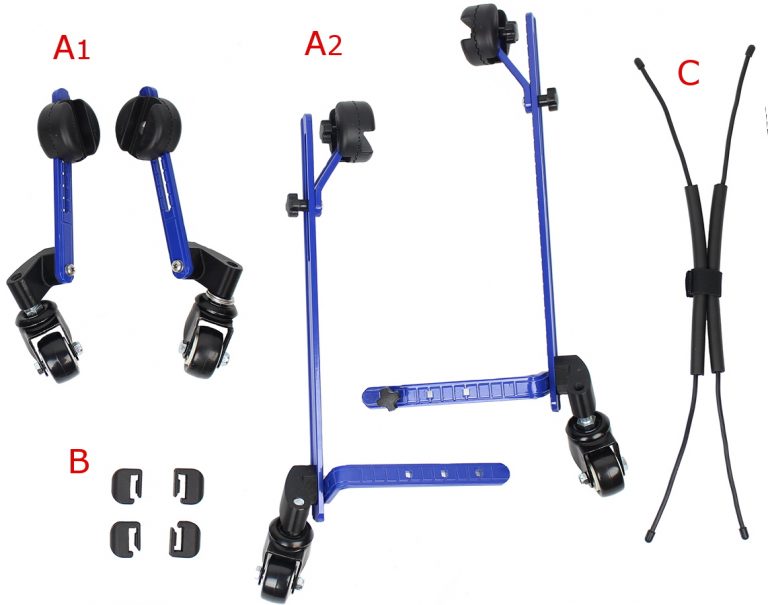
- 1 Set (2) Wheels attached to Struts & front round knuckle (A2 will come with attached stabilization bar)
- 1 Leg Ring for front legs
- 4 single Leg Ring Clamps
Rear Walkin’ Wheels Mini sold separately
(A1 OR A2) 1 Set Wheels and Struts: The wheels come attached to the struts; you will get just one set of wheels/struts, depending on the size you need. The Mini Front Wheel Attachment has 3 sizes. The larger 2 sizes (A2) come with a stabilization bar for support.
(B) Leg Ring Clamps: 4 single Clamps are included to attach to the wheelchair frame to prevent Leg Ring from sliding.
(C) Leg Ring: You will not need to use the front harness that comes with the rear wheelchair. You will install the front leg rings instead, just like the rear leg rings. Rubber-coated wires easily wrap around the wheelchair frame, forming two Cs.
Sizing
Sizing
1. Measure the Rear Leg Height to the toe pad, ideally when your pet is laying down. Do not pull the leg tight; leave some natural bend.
2. Measure your pet’s length or armpit to rump (ATR).
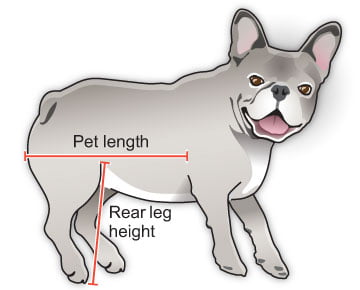
| Rear Leg Height | Pet Length (ATR) |
|---|---|
| 3-6″ | 5-8″ |
| 7-10″ | 6-10″ |
| 11-12″ | 11-14″ |
Using our SureFit® Calculator? Enter your pet’s Rear Leg Height, Pet Length, Weight and Breed to get the perfect wheelchair configuration for your pet.
Watch How to Measure Your Pet for a Walkin’ Wheels Wheelchair!
Instructions
Instructions
Here are a variety of resources to help you assemble the Walkin’ Wheels, how to put a dog into it, how to adjust the wheelchair and finetune the fit, as well as getting a dog used to their new wheelchair:
FAQ
FAQ
Can pets pee and poop in the Walkin’ Wheels wheelchair?
Yes, the Walkin’ Wheels wheelchair is designed to help pets get the exercise they and do their business mess-free.
Can pets sit in a wheelchair?
No. Our chair is designed NEVER to collapse on the dog’s leg or spine. We’ve gone to great lengths to be sure of it. The chairs are designed with the help of veterinarians and rehabilitation specialists to hold the dog up, keeping the spine and legs in the optimal position for safety and healing.
What’s more, the purpose of the chair is to give the dog exercise and the freedom to go outside and do his business. When the dog is tired, you should never leave him in the chair.
The reviews we have seen of the experimental sit-down spring-loaded style have not been positive. Although we have done a great deal of research, we have not found a safe way for a chair to collapse on a dog.
Can pets use their Walkin’ Wheels inside the house?
Yes. The Walkin’ Wheels is designed to be used both indoors and outside. If a paralyzed pet needs an indoor mobility solution that can be worn for extended periods of time, we recommend the Walkin’ Scooter.
Can dogs lie down in the wheelchair?
For dog breeds like a Corgi or Bassett Hound, it is okay for them to take a rest up against a pillow or bed, because their legs are so short. Otherwise, it is not recommended, due to back or disc issues that could worsen by laying down in the wheelchair.
Can pets use his/her rear legs in the wheelchair?
Absolutely. In fact, we encourage pets to use his/her rear legs. The Walkin’ Wheels can help pets maintain muscle mass, increase strength and exercise. If a pet’s rear legs are paralyzed, use stirrups to prevent their back legs from dragging.
How do I determine the correct size wheelchair for my patient?
It only takes a few simple measurements to determine the correct size wheelchair for you patient. Watch the video below to see how:
Watch How to Measure Your Pet’s Rear Leg Height Video!
Is the wheelchair easy to transport?
Absolutely, the Medium Walkin’ Wheels wheelchair is designed to fold flat for easy transport.
Will this wheelchair rehabilitate my dog?
We have seen varying degrees of recovery with pets using the wheelchair. Some dog’s mobility has improved so much that they no longer require a wheelchair. Every case and disability are unique. While a patient is in the wheelchair, they are getting physical therapy improving their physical and mental health.
What is the return policy?
It is our intention that every Walkin’ Wheels user be happy with their wheelchair. If you experience problems, please call us. Often, we can help with a simple adjustment. If you feel the wheelchair is not for you, we can issue a RETURN MATERIALS AUTHORIZATION. Please note that wheelchairs returned without a return materials authorization will not receive credit. Please click here for full return policy.
How do I get my dog used to their new wheelchair?
This is a great question. Over the past 20 years, we’ve determined how to best get a pet acquainted with their wheelchair. Just click here.

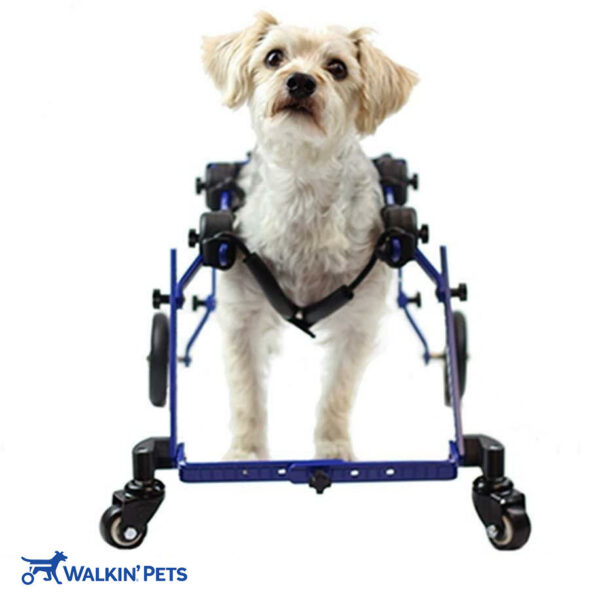
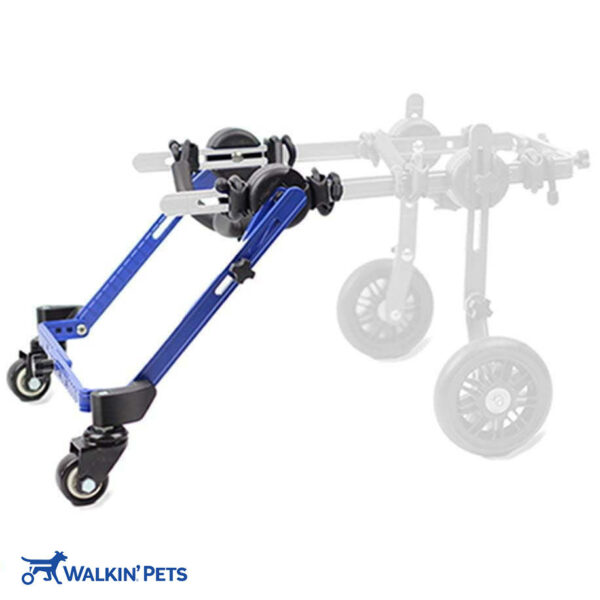
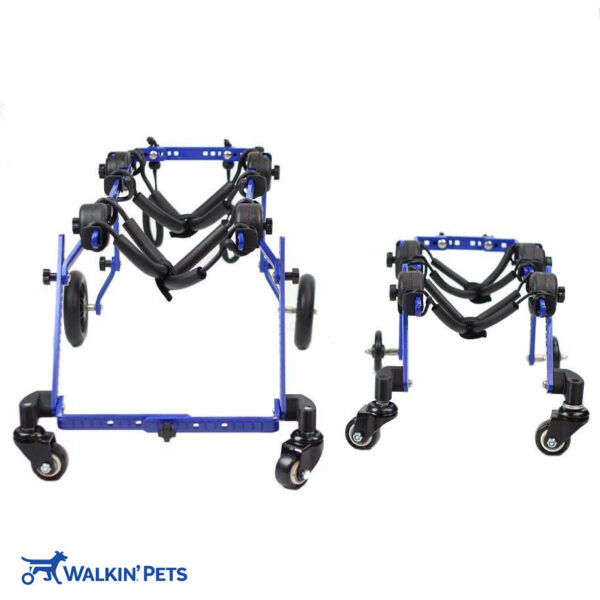
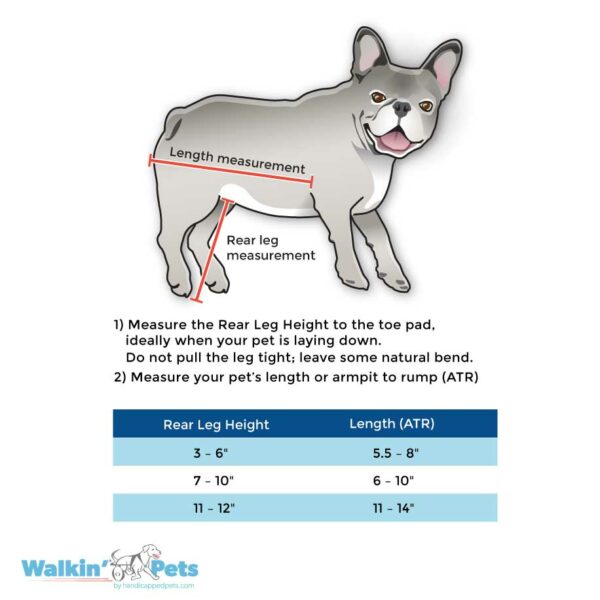
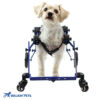
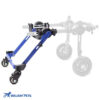
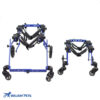
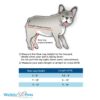


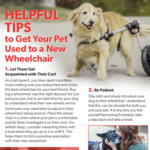
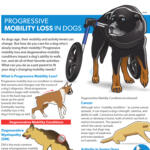
Have a question about this product?